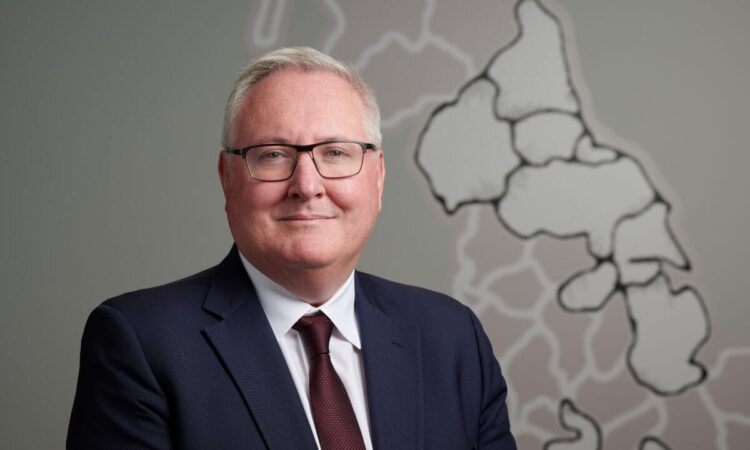
Joe McDonnell, CIO of Border to Coast, says the £45 billion fund can help fill the gap in funding UK private companies wanting to IPO. It’s part of an investment strategy by the new-ish CIO that sees a focus on putting capital to work innovatively and intentionally for its underlying funds.
Small and mid-market companies in the United Kingdom have been starved of capital for years and it is more difficult than ever for private companies that have proved themselves and need £20-£30 million to push through to an IPO to attract investment, says Joe McDonnell, chief investment officer of the £45 billion Border to Coast, touching on one of the hottest topics on the UK investment landscape.
“It has been a tough ride for these smaller companies. The Financial Conduct Authority and others have woken up to it far too late. It should have been red flagged a long time ago,” says McDonnell who joined Border to Coast in 2023 following long stints in asset management and in-house pension management at Shell and IBM.
Under his leadership the asset owner is readying to fill the gap that he says naturally falls to the £400 billion LGPS (86 local authority pension schemes now amalgamated into eight mega pools) as corporate DB pension funds continue to de-risk and DC funds, keenly focused on the lowest cost provision, struggle to move into private markets.
“We’d like to focus on this segment of the market, and we think if a company has proper UK institutional investment on the private side, they’d consider a UK listing as this is where their sponsors are,” he says, in a nod to that other much talked about absence – the lack of IPOs.
The rot is evident in the falling number of companies listing on the FTSE 250, continues McDonnell. Back in 2018, 198 of FTSE 250 constituents were companies and 52 were funds. Today the number of companies has fallen 15 per cent to 168 and the number of funds jumped nearly 60 per cent to 82, resulting in a market cap drop of companies on the FTSE 250 of 32 per cent.
“All that money has flowed to the US,” he says. “It’s had a dramatic effect on how the UK is perceived.”
Investment in the space will require a deep expertise that is out of reach for many investors and McDonnell estimates it will take two to three years to deploy money.
Although the premium offered for investors in small and mid-cap companies over large cap has slipped away over the last 20 years in favour of mega large cap like banks and oil giants, he is convinced it still exists and will play into Border to Coast’s small to mid-cap structural bias.
direct real estate
Border to Coast is also doing its part to invest in other areas of the UK too. This October it will begin running an initial £1 billion internally managed direct pooled UK real estate allocation for its 11 partner funds.
It is the final asset class to pool and involves client funds handing over around 70 direct real estate positions each in a much more complex process than building a portfolio from scratch. Like the fact each investment requires fresh environmental and legal due diligence. “We have to get comfortable with each piece of real estate before we accept it into the pool,” he says.
Correctly valuing these existing portfolios in today’s volatile real estate market with valuations moving more than at any point in the last 10 years is another headache. Selling indirect individual fund holdings so clients can assign fresh capital to the new direct allocation is also difficult, he explains.
“The market is not great for selling so it’s been a gradual process. Investors that have invested a significant amount in funds don’t want to hurry along redemptions that put a stress on the market”.
Still, it also makes for an opportune time to build out the portfolio helped by DB funds selling up as they go for buy out. “We don’t time the market, but it’s a great time to launch a real estate strategy with fresh capital because there are lots of sellers in the market.”
McDonnell says Border to Coast will make all the decisions but will be supported in terms of origination and execution by asset manager Aberdeen which has worked with some of the partner funds in the past.
He won’t define the portfolio from an asset allocation perspective and strategy will be shaped around a “go anywhere do anything” multi-asset approach. Pricing is so attractive he wants the freedom to move between segments and diversify the portfolio over time. Moreover, UK real estate is often backward looking.
“Data centres or last-mile logistics didn’t exist 10 years ago. We don’t want to be tied to a single segment of the market.”
He is mindful of the possible conflict of interest within the LGPS where pools seek to invest in infrastructure, social housing, regeneration opportunities and renewables in their own geographies. Warning that all investments must make sense from a risk/return perspective, he suggests a “national multi-asset programme with regional sensitivities.”
A centralised template where every decision on where to deploy is consistent would also help identify the best opportunities, and was the approach Border to Coast used when it launched its UK Opportunities portfolio in Q1 2024.
Future innovation
With 80 per cent of Border to Coast’s partner funds’ assets pooled – the remaining 20 per cent lies in passive equity and bonds and will stay with the individual pension funds who have “terrific pricing” with large passive managers – McDonnells says all future innovation will be around strategy.
For example, in global equity he is planning to launch a multi-factor equity index solution and is also exploring global sustainable bonds.
“You can get the same risk/return yield/duration/credit quality from a global sustainable portfolio as you can from an aggregate bond portfolio and as funding levels are at record highs, we expect to see an increase in the allocation to fixed income in the coming years.” The portfolio would also meet two objectives – diversification in fixed income and a great opportunity to transition to net-zero climate targets.
He says all strategies and funds are chosen based on communality not proliferation – he won’t launch niche strategies that aren’t scalable across multiple partner funds.
“We are conscious of using the active resources we have including dedicated research teams and internal portfolio management teams as effectively as possible,” he says. “We don’t’ think ‘let’s not do private equity and cut costs’. We make no apologies for having the right resourced team with the right headcount that allow a broad exposure to these strategies.”
Some LGPS pools have adopted a hybrid approach to pooling, or outsourced everything to a consultant but he believes Border to Coast’s model has created a resilience within the organization that sets it up for the future
“Which is the best model? This is the model I like,” he concludes.






